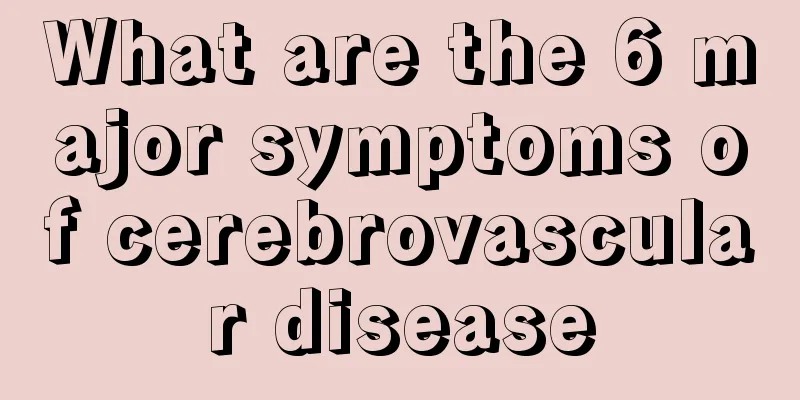What are the 6 major symptoms of cerebrovascular disease

|
Cerebrovascular disease is a relatively harmful disease, especially for the elderly, it may be directly fatal. In the early stages of cerebrovascular disease, there will be some more obvious symptoms, which should be enough to attract our attention, so that we can ensure early medical treatment and ensure that the disease is controlled in the shallow and early stages. Cerebrovascular disease refers to a group of diseases in which lesions occur in the cerebral arteries or the neck arteries that control the brain, causing obstruction of intracranial blood circulation and damage to brain tissue. The main symptoms of cerebrovascular disease are: (1) The disease starts suddenly, usually in one upper limb, and then the neurological dysfunction symptoms progressively affect other parts of the limb within a few hours or one or two days. (2) Headache Headache is a prominent symptom of subarachnoid hemorrhage. It is often a splitting pain in the entire head. For patients with cerebral hemorrhage, about 80% to 90% of them have severe headaches because the blood directly stimulates the meninges and the pain structures of the brain. The characteristic is that the pain is initially located on the affected side. When the intracranial pressure increases or blood flows into the subarachnoid space, a full headache may occur. Headaches caused by transient ischemic attack and cerebral infarction are mostly mild, but severe headaches may also occur when large-area cerebral infarction is combined with increased intracranial pressure. (3) Vomiting Vomiting is a common symptom of cerebrovascular disease, especially hemorrhagic cerebrovascular disease. For example, subarachnoid hemorrhage often presents as projectile vomiting, with an incidence rate of over 80%. When cerebral hemorrhage occurs, intracranial pressure increases, and vomiting and headaches become more severe. If the patient vomits coffee-colored stomach contents, it indicates upper gastrointestinal bleeding, which is a sign of serious illness. Vomiting is rare in patients with ischemic cerebrovascular disease, but it can also cause vomiting when there is a large area of cerebral infarction and increased intracranial pressure. (4) Impairment of consciousness is common in patients with cerebral hemorrhage and is the result of severe and extensive brain damage. It is reported that 60% to 80% of patients with cerebral hemorrhage may experience impaired consciousness. The clinical characteristics are that except for a small number of patients with mild cerebral hemorrhage who can remain conscious, the disturbance of consciousness in patients with brainstem hemorrhage and cerebellar hemorrhage is relatively serious. Patients with intraventricular hemorrhage may quickly go into a coma. The degree of consciousness disturbance after subarachnoid hemorrhage is relatively mild. Cerebral infarction rarely causes impaired consciousness, while large-area cerebral infarction is often accompanied by impaired consciousness. (5) Hemiplegia Hemiplegia refers to movement disorders of the upper and lower limbs and the tongue and facial muscles on one side. It is also a common symptom of cerebrovascular disease. Regardless of which side of the cerebral hemisphere is lesioned, it will cause hemiplegia on the opposite side of the lesion. The degree of hemiplegia can be mild or severe, ranging from incomplete paralysis to complete paralysis. Incomplete paralysis is also called mild paresis, and the patient can walk with the help of a cane. Complete paralysis is also called total paralysis, in which the patient is bedridden and unable to move on his own. Some patients may have more severe facial and tongue paralysis and less severe limb paralysis, or more severe upper limb paralysis and less severe lower limb paralysis, or more severe lower limb paralysis and less severe upper limb paralysis. The change from complete paralysis to incomplete hemiplegia indicates that the condition has improved. On the contrary, if incomplete paralysis develops into complete paralysis, it means that the condition is gradually worsening. (6) Aphasia is caused by damage to the speech center of the cerebral cortex of one hemisphere. Depending on the location of the damage and the clinical manifestations, it is divided into motor aphasia, sensory aphasia, mixed aphasia and nominal aphasia. Patients with motor aphasia have lost the ability to express themselves in language and cannot speak, but they can understand what others are saying and can answer questions with gestures or nodding. Patients with sensory aphasia cannot understand what others are saying, but because their language motor centers are intact, they can speak, and they speak quickly and fluently. However, when they talk to others, they answer questions irrelevantly. Patients with mixed aphasia have both motor aphasia and sensory aphasia. They cannot speak and cannot understand what others are saying. Anomia is a condition in which the patient can speak, understand what others say, and describe the properties and uses of objects, but cannot name the objects. |
<<: Can cooking wine be replaced by white wine? Correct understanding of cooking wine and white wine
>>: Symptoms and treatment of intrahepatic bile duct stones
Recommend
Eggs for fast male enhancement
Many men feel that their sexual function is insuf...
Signs that a man is deeply hurt in love
In a romantic relationship, getting hurt is a com...
How long does it take to cook zongzi
When cooking rice dumplings, you must control the...
Can a rice pillow correct the shape of the head
Many babies will face problems with their head sh...
Can pituitary tumors be cured?
Many patients are very worried that their health ...
Category I pollutants
Garbage must be classified, and the first type of...
What to do if there are cockroaches at home in summer
The house is relatively humid in summer, so it is...
What is the reason for the black spots on the body
Sometimes when I look in the mirror I don’t know ...
Symptoms of prostate cancer patients
The appearance of some common clinical manifestat...
Where is the stratified squamous epithelium?
The term epithelial tissue is not unfamiliar to m...
The principle of decanting red wine
People who drink red wine frequently know that re...
How to defecate when you have severe constipation?
Constipation is a very common symptom in life. Mo...
What medicine is used for epilepsy
The course of epilepsy is usually relatively long...
What is the definition of cardiopulmonary resuscitation?
The definition of cardiopulmonary resuscitation i...
How to relieve liver cancer pain? Diet recipes for liver cancer patients
Liver cancer is a common type of malignant tumor ...









